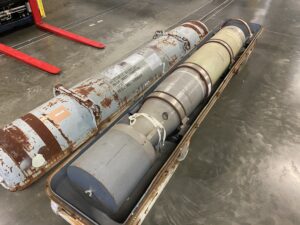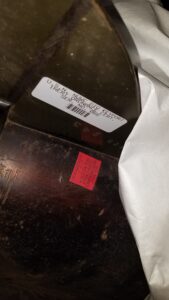 Why do we need a close relationship with the local EOD unit? That’s a good question, and I don’t bring it up to cause any panic with regard to the safety of our collection. I’ll start by saying, we foster a close relationship with our local Explosive Ordnance Disposal (EOD) unit to make sure our collection is safe.
Why do we need a close relationship with the local EOD unit? That’s a good question, and I don’t bring it up to cause any panic with regard to the safety of our collection. I’ll start by saying, we foster a close relationship with our local Explosive Ordnance Disposal (EOD) unit to make sure our collection is safe.
The Naval History & Heritage Command has broad policy requirements regarding the collection of arms, ammunition, and explosives (AA&E), but our museum sets the procedural guidance to ensure our collections are safe for staff, volunteers, and visitors. We take those command standards and add extra precautions on top of them, reconciling for the fact that collections managers are not ordnance experts who can make a determination if something is safe. Together with our Naval Base Kitsap Explosive Safety Officer, we set guidance for documentation and labeling that exceeds the standards set by the Navy – because we are not an average Navy unit.
This past month, the museum received a new artifact, transferred to us from NUWC Division Newport (Keyport’s East Cost equivalent). The artifact is a MK 44 Mod 1 Torpedo (pictured above), which had been on display at their facility; it was already inert. Before they shipped it, they provided documentation that certified its inert status, which has to be signed by both the EOD technician assessing it and a qualified supervisor. They kept a copy of the form with the torpedo at all times during its travel, ensuring that everyone interacting with it in transit was certain it is safe. Upon arrival at Keyport, however, we had it recertified. This was done because the object itself wasn’t marked as inert. Each torpedo or mine on display and in storage has an associated inert certificate that ties it to a number. Our goal is to have EOD label each object with a sticker containing this number, allowing us to easily reference its inert status. Labelling former ordnance as inert is the quickest way to reference these certificates, a vital ability in our management of these artifacts which qualify as former AA&E. Some objects wind up with multiple stickers due to changing standards or administrative requirements.

Needing to re-certify this torpedo, we were glad to make contact with the new lead for EOD Detachment Bangor. The museum is grateful for this local support, and will continue working with them to improve our records and inspect our collection. We foster this relationship to keep us, you, and the public safe – they don’t teach you this stuff in museum studies school! —Beth Sanders, Collections Manager
